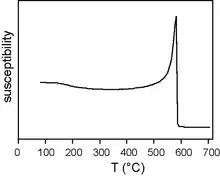
Thermomagnetic susceptibility curve for magnetite exhibiting a strong Hopkinson effect
The Hopkinson effect is a feature of ferromagnetic or ferrimagnetic materials, in which an increase in magnetic susceptibility is observed at temperatures between the blocking temperature and the Curie temperature of the material. The Hopkinson effect can be observed as a peak in thermomagnetic curves that immediately precedes the susceptibility drop associated with the Curie temperature. It was first observed by John Hopkinson in 1889 in a study on iron.[1]
In single domain particles, a large Hopkinson peak results from a transient superparamagnetic particle domain state.
See also
- Ferroelectricity – Characteristic of certain crystalline materials
- Curie's law – Relation of magnetization to applied magnetic field and temperature
References
- ↑ Hopkinson, John. “Magnetic and Other Physical Properties of Iron at a High Temperature”. Philosophical Transactions of the Royal Society of London. A 180 (1889): 443–465.
This article is issued from Wikipedia. The text is licensed under Creative Commons - Attribution - Sharealike. Additional terms may apply for the media files.